Temple Expiatori del Sagrat Cor facts for kids
Quick facts for kids Expiatory Church of the Sacred Heart of JesusTemple Expiatori del Sagrat Cor Basilica Templo Expiatorio del Sagrado Corazón de Jesús |
|
|---|---|

Entrance of the basilica
|
|
| Religion | |
| Affiliation | Roman Catholic |
| Ecclesiastical or organizational status | parish church, minor basilica |
| Year consecrated | 1952 |
| Location | |
| Location | Barcelona, Catalonia, Spain |
| Architecture | |
| Architect(s) | Enric Sagnier |
| Architectural type | Church |
| Architectural style | Neo Gothic |
| Groundbreaking | 1902 |
| Completed | 1961 |
| Specifications | |
| Direction of façade | S |
| Length | 60 metres (200 ft) |
| Width | 70 metres (230 ft) |
| Spire(s) | 5 |
The Temple Expiatori del Sagrat Cor is a beautiful Roman Catholic church located on top of Mount Tibidabo in Barcelona, Catalonia, Spain. Its name means "Expiatory Church of the Sacred Heart of Jesus."
This amazing building was designed by the Catalan architect Enric Sagnier. His son, Josep Maria Sagnier i Vidal, finished the work. The church is dedicated to the Sacred Heart of Jesus. Its construction started in 1902 and was completed in 1961.
Contents
History of the Church
The idea for building a Catholic church on Tibidabo mountain began in the late 1800s. There were rumors that a Protestant church and a hotel-casino might be built there. Because of this, a group called the "Board of Catholic Knights" bought the land. They gave it to Saint John Bosco in 1886. He was visiting Barcelona at the time.
A kind lady named Dorotea de Chopitea helped a lot with this project. The idea was to build a church dedicated to the Sacred Heart of Jesus. This was a very popular idea back then, encouraged by Pope Leo XIII. Similar churches were built in Rome and Paris.
In 1886, a small neo-Gothic hermitage (a small chapel) was built. Two years later, for the Universal Exposition, a road was built. A special viewing pavilion was also added next to the hermitage.
The main church project was delayed for a while. This was because there was a plan to build an astronomical observatory on Tibidabo. That observatory was eventually built on a nearby hill. Finally, on December 28, 1902, the first stone of the church was laid. The Bishop of Barcelona led the ceremony.
The lower part of the church, called the crypt, was built between 1903 and 1911. The main church above it was built from 1915 to 1951. The church was officially opened in 1952. This happened during a big event called the 35th Eucharistic Congress in Barcelona. The tall towers were finished later, with all work ending in 1961. In October 1961, Pope John XXIII gave the church the special title of minor basilica.
Outside the Church
The church looks like a strong Romanesque fortress at the bottom. This lower part, the crypt, is made of stone from Montjuïc mountain. On top of it is a huge neo-Gothic church. You can reach the upper church by two grand outdoor stairways.
The upper church has a central area with an eight-sided dome. This dome is supported by eight columns. At the very top of the dome is a large statue of the Sacred Heart. The first statue was destroyed in 1936. A new one was put in its place in 1950.
The upper church is square-shaped with three rounded sections called apses. It has one large central tower and four smaller towers at each corner. These towers have statues of the Twelve Apostles. The front of the church has three parts. The middle part is wider. It features a statue of the Archangel Michael above the main entrance. Above that is a statue of John Bosco. On the left door is a statue of Teresa of Ávila, and on the right is Marguerite Marie Alacoque.
The front of the crypt is beautifully decorated. It has sculptures showing the Virgin of Mercy, Saint George, and Saint James. These are the patron saints of Barcelona, Catalonia, and Spain. The crypt's facade has three semicircular arches. These are under a larger arch. This larger arch used to have a mosaic of the Holy Trinity. It was destroyed in 1936 and replaced in 1955. The new mosaic shows Spain's devotion through its patron saints.
Inside the Church
The inside of the church has a main nave and two side aisles. It has rounded sections called apses. You'll see many beautiful stained glass windows and four large rose windows. At the main altar, there is a large crucifix.
The windows near the altar are dedicated to important figures like Pius X and John the Evangelist. The left side altar has five stained glass windows. These show different ways people honor the Virgin Mary. For example, they show the Virgin of Antipolo from the Philippines and Our Lady of Guadalupe from Mexico.
The right side altar has a statue of the Risen Jesus. Its stained glass windows are dedicated to Spanish ways of honoring Mary. These include the Virgin of Almudena from Madrid and the Virgin of Núria from Catalonia.
The windows in the four towers have the Latin phrase tibi dabo. This means "I'll give you," which is where the mountain's name, Tibidabo, comes from. Other windows show important saints like Ignatius of Loyola and Rose of Lima. The eight stained glass windows in the dome show scenes from the life of Jesus.
Statue of Jesus

The very top of the church is crowned by a huge bronze statue of the Sacred Heart. This statue was made in 1950. It replaced an earlier one that was destroyed at the start of the Spanish Civil War in 1936. The journey from the crypt, through the church, and up to the statue is meant to show a spiritual journey.
The Crypt
The crypt, the lower part of the church, is designed in a neo-Byzantine style. It mixes Gothic and classical elements. The decoration also has touches of Modernisme, a Spanish art movement.
The crypt has five naves (sections) separated by columns. The central nave is wider. All sections have semicircular apses. The walls and vaults (curved ceilings) are covered with alabaster stone. They are also decorated with mosaics. These mosaics show scenes related to the altars inside, such as Mary Help of Christians and Saint Joseph.
Colorful alabaster is also used for the Via Crucis (the Stations of the Cross). These are sculptures showing Jesus's journey to the cross. The crypt gets natural light from windows. These windows also have stained glass showing different religious scenes. For example, they show the appearance of the Our Lady of the Pillar.
From the crypt, you can go into a special chapel. This chapel is dedicated to Perpetual Adoration. It was dug into the mountain in the late 1940s. It has three naves and is decorated with marble and mosaics. Paintings on the ceilings show more religious art.
Outside the crypt, on both sides of the main door, there are two staircases. These lead up to the main level of the church.
Gallery
See also
 In Spanish: Templo Expiatorio del Sagrado Corazón para niños
In Spanish: Templo Expiatorio del Sagrado Corazón para niños
- Enric Sagnier
- Modernisme
- The model of this church in Catalunya en Miniatura.















